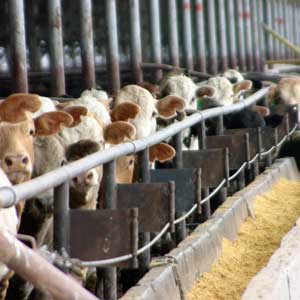A Continuous Cycle





December 13, 2006
BY Dave Nilles
The ethanol plant taking shape just west of Omaha, Neb., may not seem extraordinary. In fact, E3 BioFuels Chairman and CEO Dennis Langley would likely tell you as much. However, it's the concept surrounding the entire E3 BioFuels project—not just the plant itself—that may be setting a new standard for efficient energy production.
Langley says the secret to his revolutionary ethanol project's energy source is an oxymoron—clean manure. The 24 MMgy ethanol plant was sized according to the Mead Cattle Company's existing 300-acre, 30,000- head cattle feedlot, which has been in operation since the late 1960s. It's one of the nation's few feedlots featuring slatted concrete floors to collect manure, Langley says.
The slatted floor allows manure to fall through and be quickly transported to a storage pond where it has traditionally been collected and used for fertilizer. Next year, larger feedlots may be impacted by new U.S. EPA regulations designed to limit the amount of water pollution created by animal waste runoff from concentrated animal feeding operations.
E3 BioFuels has a solution that will allow the company to adhere to the new regulations and, at the same time, operate its plant more efficiently. The company plans on using the 228,000 tons of manure produced each year and, through proven technology, turn it into fuel to operate an ethanol plant.
Anaerobic digestion has been used for years, says Ted Mathews, who manages the operation of E3's two 4 million-gallon anaerobic digestion tanks. He previously used the technology to convert cheese whey into electricity and cattle feed in New York. Biothane Corp. provided the anaerobic digesters that will turn cattle manure and the ethanol plant's thin stillage into biogas. The biogas in turn will be used to fuel the ethanol plant's stainless steel boilers. The biogas is primarily composed of carbon dioxide and methane, and will replace the natural gas that is typically used to power Midwest ethanol plants.
Mathews is already loading the digesters with manure in anticipation of the planned ethanol plant start-up later this month. He says it takes approximately 60 days to get the digesters running at optimum levels. The time lapse allows the microbes used to create biogas a chance to become accustomed to a consistent manure supply. Once the ethanol plant starts up, thin stillage will make up a majority of the digester's feedstock, Mathews says. It's a process never before attempted at this large of a scale. "This degree of thin stillage with manure hasn't been done before," he says. However, tests conducted on pilot-scale plants have proven its validity.
The thin stillage also fulfills the digester's heat requirements. Natural gas is currently being used to operate the digesters, but the stillage's heat is expected to maintain the operating temperature of approximately 100 degrees Fahrenheit.
The plant's distillers wet grains may also be fed into the digester. However, at the E3 plant, a majority of the grains will be fed directly to the cattle. Because of that, the Mead plant doesn't require a thermal oxidizer or dryers to dry the distillers grains, which equates to additional energy savings.
The closed-loop system promises to provide impressive energy savings. By producing its own energy and distillers wet grains, E3 BioFuels is essentially burying the energy balance equation, according to Langley.
A traditional corn-to-ethanol facility has a generally accepted energy balance equation of approximately 2.8 units of energy produced for every one unit consumed. Langley says he expects E3 to best that ratio, not even taking into account the solids produced as an anaerobic digester coproduct. The remaining solids, which are formed during the 21-day process of retention in the digesters, can be sold as an aqueous ammonia fertilizer.
Another startling calculation comes from the energy produced by the anaerobic digesters. Langley says the cost savings associated with using biogas because of its relative energy content is equivalent to paying 47 cents per MMBtu for natural gas. Langley says a third-party study will be conducted to verify the energy balance of the plant once the plant is producing.
Dilling Mechanical Inc. is building the seven-acre ethanol plant with a process technology provided by Katzen International Inc. The project was on schedule until a tornado collapsed two ethanol storage tanks. The tornado hit in late September and delayed ethanol production until at least late November.
More closed-loop plants are on the drawing board, Langley says. He says E3 plans to build six projects over the next two years.
"The ethanol industry produces the most critical fuel for achieving energy independence," Langley says. "It allows us to cease being captive to geopolitical issues. It's vital to national security, energy and environmental issues. Ethanol is an appropriate solution for all of that, in addition to revitalizing the agriculture industry."
More information on E3 BioFuels is available at www.e3biofuels.com.
Langley says the secret to his revolutionary ethanol project's energy source is an oxymoron—clean manure. The 24 MMgy ethanol plant was sized according to the Mead Cattle Company's existing 300-acre, 30,000- head cattle feedlot, which has been in operation since the late 1960s. It's one of the nation's few feedlots featuring slatted concrete floors to collect manure, Langley says.
The slatted floor allows manure to fall through and be quickly transported to a storage pond where it has traditionally been collected and used for fertilizer. Next year, larger feedlots may be impacted by new U.S. EPA regulations designed to limit the amount of water pollution created by animal waste runoff from concentrated animal feeding operations.
E3 BioFuels has a solution that will allow the company to adhere to the new regulations and, at the same time, operate its plant more efficiently. The company plans on using the 228,000 tons of manure produced each year and, through proven technology, turn it into fuel to operate an ethanol plant.
Anaerobic digestion has been used for years, says Ted Mathews, who manages the operation of E3's two 4 million-gallon anaerobic digestion tanks. He previously used the technology to convert cheese whey into electricity and cattle feed in New York. Biothane Corp. provided the anaerobic digesters that will turn cattle manure and the ethanol plant's thin stillage into biogas. The biogas in turn will be used to fuel the ethanol plant's stainless steel boilers. The biogas is primarily composed of carbon dioxide and methane, and will replace the natural gas that is typically used to power Midwest ethanol plants.
Mathews is already loading the digesters with manure in anticipation of the planned ethanol plant start-up later this month. He says it takes approximately 60 days to get the digesters running at optimum levels. The time lapse allows the microbes used to create biogas a chance to become accustomed to a consistent manure supply. Once the ethanol plant starts up, thin stillage will make up a majority of the digester's feedstock, Mathews says. It's a process never before attempted at this large of a scale. "This degree of thin stillage with manure hasn't been done before," he says. However, tests conducted on pilot-scale plants have proven its validity.
The thin stillage also fulfills the digester's heat requirements. Natural gas is currently being used to operate the digesters, but the stillage's heat is expected to maintain the operating temperature of approximately 100 degrees Fahrenheit.
The plant's distillers wet grains may also be fed into the digester. However, at the E3 plant, a majority of the grains will be fed directly to the cattle. Because of that, the Mead plant doesn't require a thermal oxidizer or dryers to dry the distillers grains, which equates to additional energy savings.
The closed-loop system promises to provide impressive energy savings. By producing its own energy and distillers wet grains, E3 BioFuels is essentially burying the energy balance equation, according to Langley.
A traditional corn-to-ethanol facility has a generally accepted energy balance equation of approximately 2.8 units of energy produced for every one unit consumed. Langley says he expects E3 to best that ratio, not even taking into account the solids produced as an anaerobic digester coproduct. The remaining solids, which are formed during the 21-day process of retention in the digesters, can be sold as an aqueous ammonia fertilizer.
Another startling calculation comes from the energy produced by the anaerobic digesters. Langley says the cost savings associated with using biogas because of its relative energy content is equivalent to paying 47 cents per MMBtu for natural gas. Langley says a third-party study will be conducted to verify the energy balance of the plant once the plant is producing.
Dilling Mechanical Inc. is building the seven-acre ethanol plant with a process technology provided by Katzen International Inc. The project was on schedule until a tornado collapsed two ethanol storage tanks. The tornado hit in late September and delayed ethanol production until at least late November.
More closed-loop plants are on the drawing board, Langley says. He says E3 plans to build six projects over the next two years.
"The ethanol industry produces the most critical fuel for achieving energy independence," Langley says. "It allows us to cease being captive to geopolitical issues. It's vital to national security, energy and environmental issues. Ethanol is an appropriate solution for all of that, in addition to revitalizing the agriculture industry."
More information on E3 BioFuels is available at www.e3biofuels.com.
Advertisement
Advertisement
Advertisement
Advertisement
Upcoming Events





